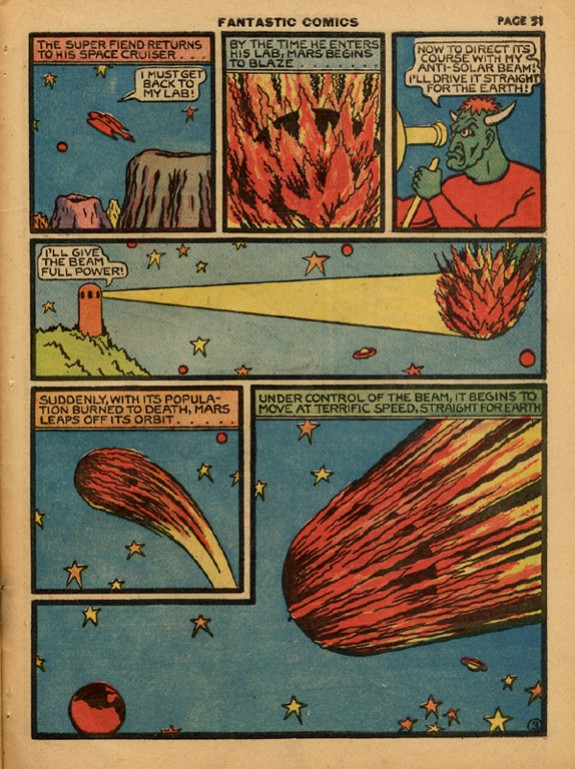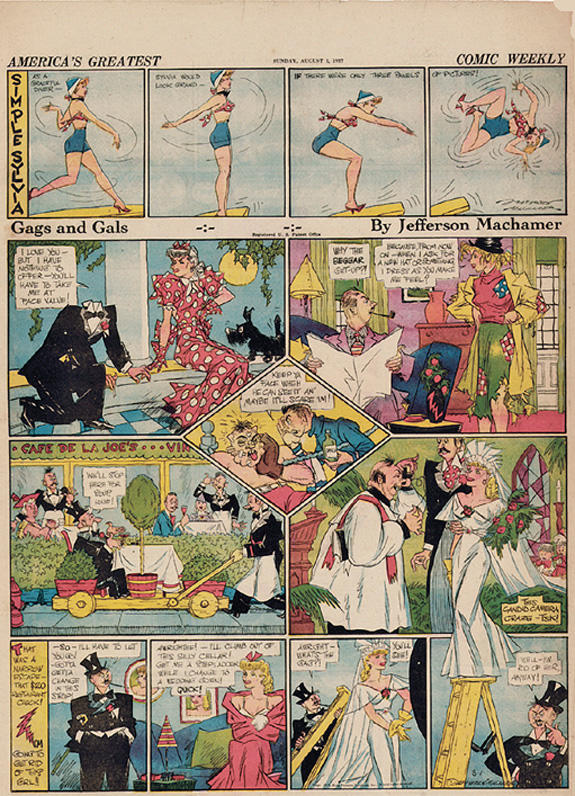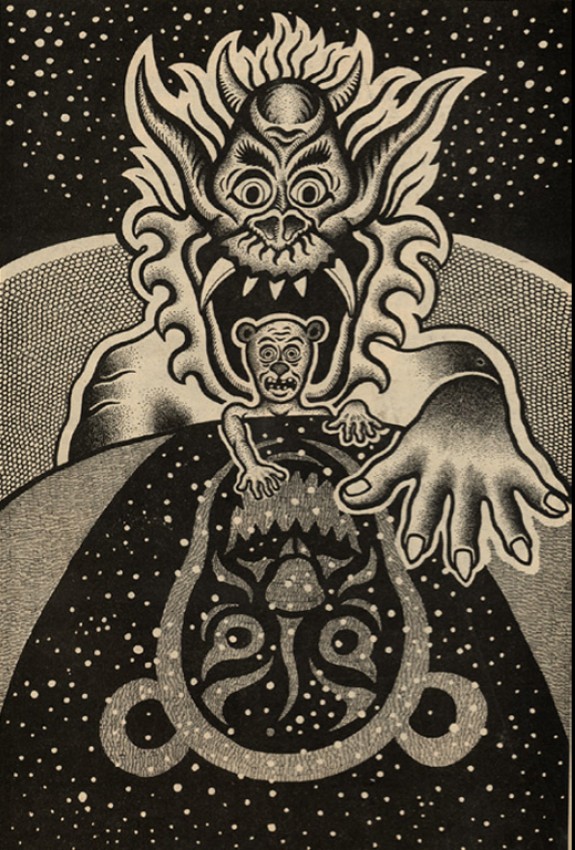 Home > Commentary and Features
Home > Commentary and Features Preview: Art Out Of Time, Dan Nadel
posted May 20, 2006
Preview: Art Out Of Time, Dan Nadel
posted May 20, 2006


There was a time not too long ago when even the most devoted comics fans looked at the history of the comic book and comic strip medium through the lenses provided them by publicity maestros like Stan Lee and comic strip collectors with publishing connections like Bill Blackbeard and Rick Marschall. That's not to equate PR-mindful "history" with necessary archival work. It's just to point out that comics culture has struggled to remember even
popular performers of the past that lack a present-day champion -- say the cartoon panels of Jimmy Hatlo, or the comic books of Charles Biro. Many worthy artists fade from view entirely. This has made it extremely difficult for critics to create for themselves a personal view of comics that depends on their idiosyncratic reactions to a wide array of material. I'm as orthodox a critic as there is, but I definitely miss hearing voices that have built their own highly-refined view of comics from the ground up, clanking up the moutainside with strange metal pieces sticking out at the joints.
With
Art Out Of Time (0810958384 $40), the publisher, designer and writer about comics Dan Nadel takes a look a some of the underappreciated and outright forgotten cartoonists from decades past. Nadel seems to be working from the idea that before there was an alternative or underground, cartoonists who were a square peg in the comics industry round hole made up of Golden Ages, Silver Ages, Disneys and Dells worked in mainstream comics anyway, with some furiously odd results. I asked for five pages from the handsomely designed Harry N. Abrams volume due June 1, and then bypassing the well-realized biographies at book's end asked for something more basic -- Nadel's immediate, off-the-cuff, on-the-phone reaction to each artist and their inclusion in his book. I like
Art Out Of Time a lot, and suggest everyone who values the joy of discovery and finding what's in the medium's more curious corner at least give it a look.
*****
Fletcher Hanks

"Fletcher Hanks I like graphically. Some people might call him a primitive, but what's so great about him is that he took this idea of superheroes as gods
literally, even before anyone articulated the idea. He made these moving statues. You have characters carved out of granite, moving around the page, and then maybe he got lucky with whomever was coloring the Fiction House stuff. There are these clunky outlines of bodies and this gorgeous flat color laid over it. Icons moving across the page. Granite statues. It's really intriguing. Every single Fletcher Hanks comic I've seen is like that. They're just these incredible visions of statues in motion. The writing is just bizarre, so intense and vicious -- maybe one of the more visceral comics in there."
*****
Ogden Whitney

"Ogden Whitney is currently my absolute favorite cartoonist in the world. I'm obsessed. I've been buying up original art, everything I can find. It's a mix of Whitney and the guy who wrote them all, a guy named Richard Hughes. I swear to God, Whitney was using clip art more than any other artist ever.
"I just wrote a piece about Ogden Whitney and Wally Wood, this idea of frozen moments in comics. Whitney is a master of psychological distress. He had these super-bland faces; nobody looks distinctive. But then he'll throw in these crazy close-ups, or very oddball compositions, where things are static in space. I find them really compelling, almost terrifying.
"If you read his romance comics -- which I didn't include in there because I ran out of room, although I really wish I had -- they're the weirdest romance comics ever. And the greatest, I think, except for [Jack] Kirby's, which are unbelievably good. His version of men and women courting is men and women terrorizing each other for eight or sixteen pages. Pure terror. Psychological warfare. Also the thing about Whitney I like so much is that it's like phonebook art, it's so generic it's unique. It's like digging a hole in the earth and getting to China. You come out the other side and it's so unique."
*****
Jefferson Machamer

"Jefferson Machamer is really interesting. I got into Machamer because... I can't remember why anymore, actually. I got into him somehow and my interest was further piqued because he was a huge influence on Gary Panter. We'll talk about that sometimes, and he kind of pushed me along on Machamer a bit. I like him because it's the only approach I've seen with girly stuff that's about the mark making and these almost violent images. Expressionist girly gag cartooning.
"I love the way he draws. It's all about the drawing with Machamer. These great gestures, these really precise and expressive lines. All his women are these Amazonian women that are kind of carved out of space with slashed lines, and all his men are short, balding dudes. It's very fetish-y and Crumb-like. I really like the way he designs pages. It's very unusual, this multi-gag format all designed on a single page. Mark Newgarden did it years later without knowing about it, and Chris Ware does it. It's a nice format."
*****
Dick Briefer

"Dick Briefer I included because he was one of the few guys in the 1940s who had that loose, gestural art style that's funny. The drawing is inherently funny. Which is really unusual for humor comics of the time, like Little Lulu -- which I love -- or Carl Barks, where it's tight drawing. It's self-contained and beautiful. But Briefer is all over the place. When he does these swooping pratfalls that Frankenstein takes, the lines actually reflect the gag. It's nice. And it's so funny he turned Frankenstein into a humor character. And they're funny as comics. They read well and are beautifully drawn, they're full of unforgettable images, like the wizard eating Frankenstein on a hot dog. You'll never forget it, for better or for worse."
*****
Rory Hayes

"Hayes to me is the ultimate underground artist. He took the tropes of EC Comics, the sort of horror genre tropes, and then just drew them horrifically as a reflection of the subject matter. That's really nice, as opposed to the elegantly modeled drawings of EC or the guys that tried to do EC in the undergrounds -- like Roger Brand and [Richard] Corben and [Jack] Jackson and these guys. All of whom I like -- okay, maybe not all of them. I have a soft spot for Corben in the same way I have a soft spot for [Frank] Frazetta. It's so retarded you gotta respect it.
"Hayes I like because he wasn't afraid to just draw as horrifically as he felt. And nobody was really drawing like that before then. This really savage drawing that has no reference outside of his own internal landscape. Hanks' is weird drawing, but it resembles superhero drawing. It's in the family. But Hayes is his own family. That's why I chose him.
"Also, Hayes is the end of that era. That's where it ends for me. These guys that needed a home for their visions -- if you were Boody Rogers in '69 you did underground comix and got laid a lot. But Hayes even then was still an outsider. He may have been the last true outsider of comics. Now even a guy like Mark Beyer is published by Random House."


